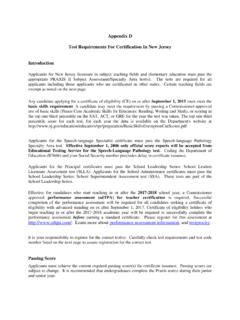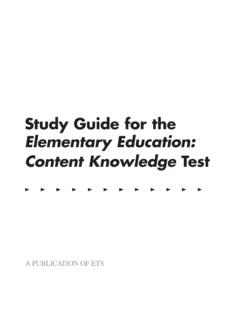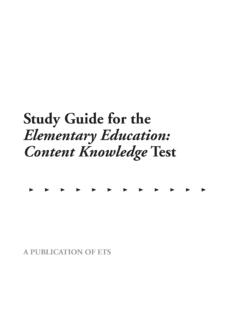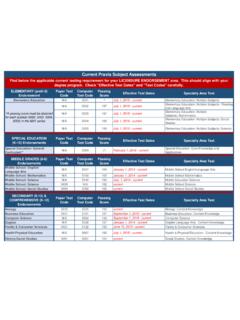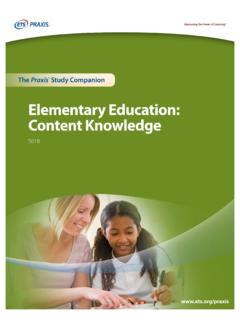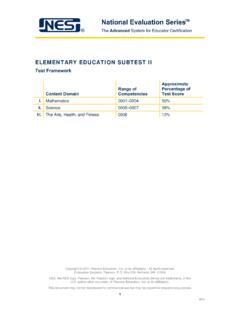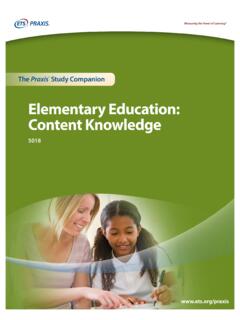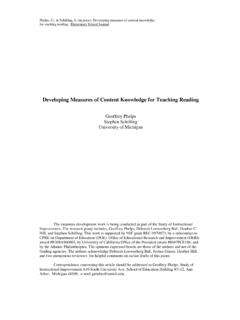Transcription of A Study of Geometry Content Knowledge of Elementary ...
1 International Electronic Journal of Elementary Education, 2015, 7(3), 301-318. ISSN:1307-9298 Copyright IEJEE A Study of Geometry Content Knowledge of Elementary preservice Teachers Fatma ASLAN-TUTAK Bogazici University, Turkey Thomasenia Lott ADAMS University of Florida, USA Received: 3 March 2015 / Revised: 17 May 2015 / Accepted: 27 May 2015 Abstract The purpose of this research is to examine preservice Elementary school teachers Geometry learning as investigated by both qualitative and quantitative methods. For the qualitative investigation, narrative analysis and thematic analysis methods were used. The findings of narrative analysis indicated two main kinds of stories: as a learner and as a beginning teacher. The thematic analysis findings yield to three themes: history of learning Geometry , perceptions about Geometry , effective Geometry instructional practices. The findings informed the quantitative investigation on Geometry Content Knowledge for the case of quadrilaterals.
2 During the second phase of the Study , 102 participants who enrolled in the methods course completed pre and post test of teachers Geometry Content Knowledge . Treatment group participants (n=54) received series of activities ( Geometry activities and student work analysis) focusing on quadrilaterals, and control group participants (n=48) received traditional instruction. Repeated measures ANOVA results showed a significant change in treatment group participants Geometry Content Knowledge . The mixed ANOVA results indicated a significant main effect of Knowledge but no significant interaction between Geometry Content Knowledge and grouping. Even though treatment group participants Geometry Content Knowledge growth was significant, the difference between treatment group and control group participants growth in Geometry Content Knowledge was not significant. This Study informs mathematics teacher education in three important areas; limited Knowledge of preservice teachers Geometry Content Knowledge , integrating mathematics Content and the context of teaching into methods course, and use of student work with preservice teachers.
3 Keywords: Teachers mathematics Content Knowledge , Geometry , mathematical Knowledge for teaching, Elementary school preservice teachers. Fatma ASLAN-TUTAK, Secondary School Science and Mathematics Education, Faculty of Eductaion, No:510, Bogazici University, Phone: +90 212 3594610, E-Mail: International Electronic Journal of Elementary Education , Issue 3, 301-318, 2015 302 Christiana was excited to go to her first class in university after transferring from the community college of the same city. She was hopeful to be a good teacher. On her way to mathematics course, she remembered her mathematics teachers throughout her education. She regretted that none of them had inspired her to learn mathematics. She wanted to have a new start with this university because she cared about her future students from then. She wanted to learn mathematics that she previously avoided, and she wanted to know everything about teaching mathematics to be the good teacher that she never had.
4 Christiana is one of the participants who told her story of learning Geometry for the Study discussed in this manuscript. This article reports a two-phase research Study which integrated qualitative and quantitative research methods to Study preservice Elementary teachers Geometry learning and their Geometry Content Knowledge . The first phase of the Study was the qualitative investigation to understand preservice teachers Geometry learning. Integration of results from the Study of effective Geometry learning experiences of preservice teachers and teacher education literature, the researcher developed series of activities for a mathematics methods course. Those activities used as the intervention for the quasi-experimental quantitative phase with purpose of improving the Geometry Content Knowledge of preservice teachers. This article will report (i) the qualitative investigation on preservice Elementary teachers Geometry learning, (ii) the development of the activities as a result of that investigation, and (iii) studying the effect of the activities by a quantitative investigation.
5 Introduction The most commonly accepted definition of teacher Knowledge was given by Shulman (1986, 1987), who developed a model of teacher Knowledge . His definition is consisted of three types of teacher Knowledge : subject matter Knowledge (SMK), pedagogical Content Knowledge (PCK) and curriculum Knowledge . SMK refers to Knowledge base of the Content one is teaching, such as mathematics. PCK goes beyond Knowledge of subject matter per se to the dimensions of subject matter Knowledge for teaching (Shulman, 1986, p. 9). PCK is the type of Knowledge that distinguishes the work of a teacher from the work of a scientist. The third Knowledge type, curriculum Knowledge , addresses effective use of curriculum materials and teachers familiarity with other subjects studied. Among these Knowledge types, subject matter Knowledge stands out as a point of interest for teacher education. Brown and Borko (1992) asserted that preservice teachers limited mathematics Content Knowledge may hinder their pedagogical training.
6 Also, other studies have shown that lack of subject matter Knowledge affects teacher s methods of teaching ( Carpenter, Fennema, Peterson & Carey, 1988; Leinhardt & Smith, 1985). Carpenter and his colleagues (1988) emphasized that subject matter Knowledge of a teacher heavily affects the teachers use of the pedagogical tools. Even though SMK is emphasized greatly in teacher Knowledge , the type of mathematics is not just to solve problems mathematically correct (Ball, 1988, 1990a, 1990b; Leinhardt and Smith, 1985; Owens, 1987; Post, Harel, Behr, & Lesh, 1988; Steinberg, Haymore, & Marks, 1985). In the mathematics education field, Ball and a group of researchers developed mathematical Knowledge for teaching (MKT) as following the Shulman s model for teacher Knowledge . MKT model addresses how a teacher uses mathematics for teaching while emphasizing the importance of mathematics Knowledge in teaching settings (Ball, 2000).
7 According to MKT model, there are six domains of teacher s Content Knowledge which can be categorized under Shulman s different types of Knowledge (Ball, Thames & Phelps, 2008). There are three domains under subject matter Knowledge : common Content Knowledge (CCK, mathematics Knowledge not unique to teaching), specialized Content Knowledge (SCK, mathematics Knowledge unique to teaching), and horizon Content Geometry Content Knowledge of Elementary preservice teachers / Aslan-Tutak & Adams 303 Knowledge ( Knowledge of mathematics throughout the curriculum). Also, there are three domains under pedagogical Content Knowledge : Knowledge of Content and students (KCS, interaction of Knowledge of mathematics and students mathematical conceptions), Knowledge of Content and teaching (KCT, interaction of Knowledge of mathematics and teaching methods), and Knowledge of Content and curriculum (interaction of Knowledge of mathematics and mathematics curriculum).
8 This model was used wide spread in mathematics education research. There were also efforts to adapt or improve the model according to different contexts. For the international comparison Study on preservice mathematics teachers (Tatto et al., 2008), MKT model and the teacher Knowledge instrument inspired TEDS-M Study . Furthermore, Mathematics Teachers Specialized Knowledge (MTSK) was developed by Carillo and his colleagues in order to strengthen the connection to classroom practices (Carrillo, Climent, Contreras, & Mu oz-Catal n, 2013). Content Knowledge of teachers is important for every subject including Geometry , one of the most applicable topics to daily life, yet, which is often a neglected topic in the curriculum. There are several studies on teachers Knowledge of mathematics focused on topics such as fractions (Carpenter et. al, 1988) or numbers and operations (Ball, 1990; Ma, 1999).
9 The limited number of research projects focused on Knowledge of Geometry for teaching concludes that beginning teachers are not equipped with necessary Content and pedagogical Content Knowledge of Geometry , and it is important to address this issue in teacher education (Browning, Edson, Kimani, Aslan-Tutak, 2014; Jones, 2000; Swafford, Jones, & Thornton, 1997). Studies on Geometry Content Knowledge of teachers emphasized the lack of teachers Knowledge , especially the beginning teachers (Barrantes & Blanco, 2006; Chinnappan, Nason, & Lawson, 1996; Jacobson & Lehrer, 2000; Lampert, 1988; Leikin, Berman, & Zaslavsky, 2000). Teachers are expected to teach Geometry when they are likely to have done little Geometry themselves since they were in secondary school, and possible little even then. (Jones, 2000, p. 110). Therefore, this Study is an effort to improve mathematics teacher education in Geometry .
10 This Study s most important characteristic is to understand preservice teachers needs and strengths from their perspective in order to address their Geometry learning needs to enhance their Geometry Content Knowledge . There were four research questions, first two to address Geometry learning (studied by qualitative research methods) and the last two to address Geometry Content Knowledge of preservice teachers (studied by quantitative research methods): 1. What are participating preservice Elementary teachers perceptions of Geometry in Elementary school who were enrolled in mathematics methods course? 2. What are the perceptions of participating preservice Elementary teachers on effective instructional strategies to promote their Knowledge of Geometry in the mathematics methods courses? 3. Does use of Geometry activities focused on quadrilaterals with analysis of student work influence preservice Elementary teachers Geometry Content Knowledge ?










